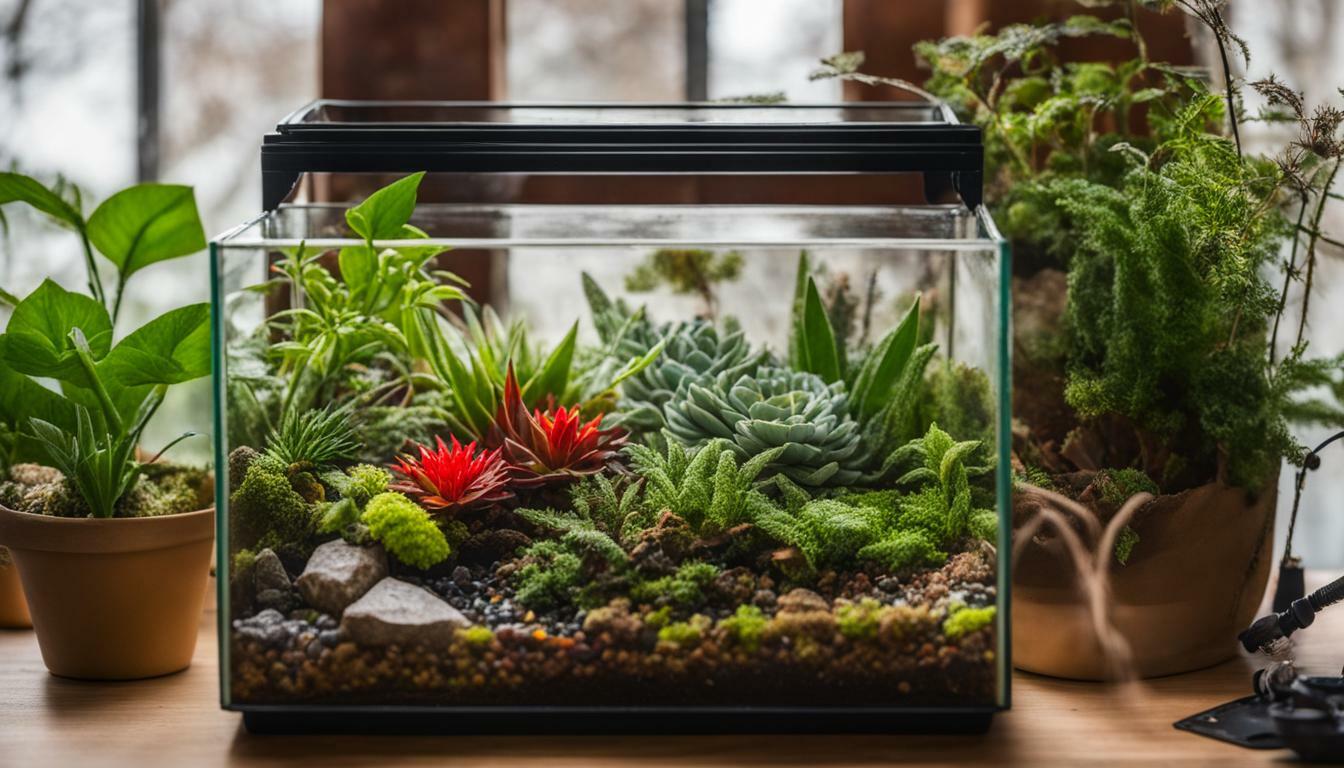Terrarium care requires seasonal adjustments to ensure the well-being of your mini ecosystem. Proper care and attention are essential to maintain healthy and thriving terrariums throughout the changing seasons. From understanding light requirements to choosing suitable plants and containers, this guide will provide you with valuable insights to master terrarium care.
Key Takeaways:
- Position your terrarium based on the light requirements of your plants and the changing seasons.
- Water open and closed terrariums differently, adjusting frequency according to the needs of each type.
- Prune and maintain your terrarium regularly to ensure its long-term health and beauty.
- Troubleshoot common seasonal issues that may arise in your terrarium and take appropriate actions.
- Follow essential tips to care for your terrarium during the settling-in period and adapt it to seasonal changes.
Understanding Terrarium Light Requirements and Placement
Proper understanding of light requirements and placement is crucial for successful terrarium care throughout the seasons. Terrariums are unique miniature ecosystems that rely on the right amount and quality of light to support plant growth and maintain a healthy environment. When positioning your terrarium, it’s important to consider factors such as the type of terrarium (open or closed) and the specific light needs of the plants you have chosen.
Open terrariums thrive in bright, indirect light. Placing them near a window with partial sun exposure allows them to receive the right amount of light without being exposed to direct sunlight, which can lead to scorching or overheating. The presence of natural light is beneficial for photosynthesis and overall plant growth. However, it’s important to monitor the temperature inside open terrariums, as excessive heat can cause plants to wilt or wither. Adjusting the positioning of your open terrarium as the seasons change can help ensure it receives optimal light throughout the year.
Closed terrariums, on the other hand, require less light than open terrariums. These enclosed environments can create a humid atmosphere that supports moisture-loving plants. Placing closed terrariums away from windows and direct sunlight helps prevent excessive heat buildup and maintains a more stable temperature. Indirect or filtered light from artificial sources can be sufficient for closed terrariums. Regularly monitoring the plants inside closed terrariums can help ensure they are receiving the right balance of light and humidity.
| Open Terrariums | Closed Terrariums |
|---|---|
| Placement: Near windows with partial sun exposure | Placement: Away from windows and direct sunlight |
| Light Requirements: Bright, indirect light | Light Requirements: Less light, indirect or filtered artificial light |
Remember to observe and assess your terrarium regularly, ensuring that the plants are not receiving too much or too little light. Adjusting the positioning of your terrariums based on the changing seasons can help maintain optimal light conditions and promote healthy growth. By understanding the light requirements and proper placement, you can master terrarium care and enjoy thriving little ecosystems in your home.
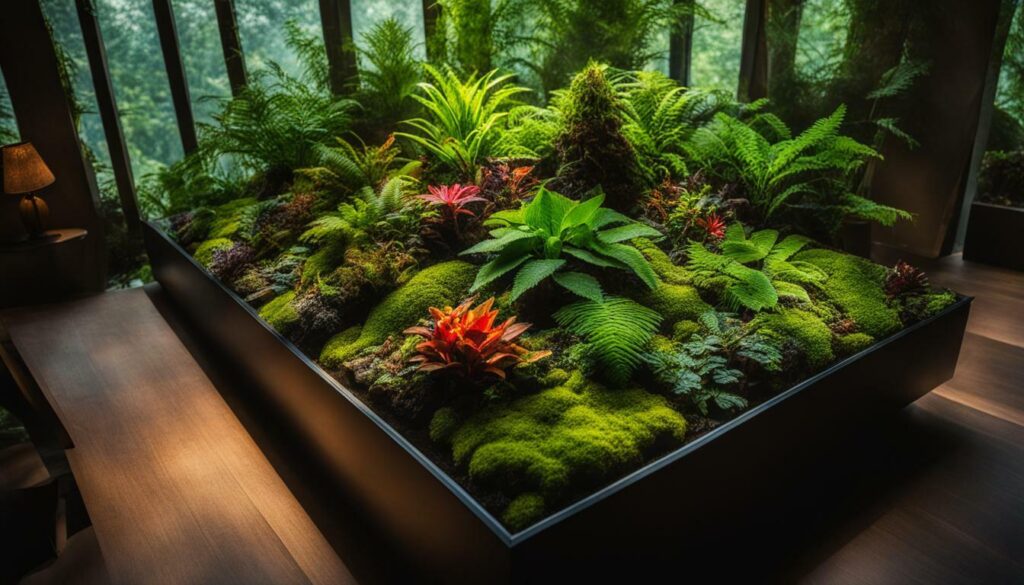
“Proper positioning of your terrariums ensures that your plants receive the right amount of light to flourish throughout the seasons.” – Terrarium Care Expert
Watering Terrariums Based on the Season
Adjusting your watering routine based on the season is essential to maintain a healthy terrarium. Proper watering is crucial for the overall well-being of the plants inside. Let’s explore some seasonal care tips to ensure your terrarium thrives throughout the year.
Open Terrariums
Open terrariums, with their exposed tops, are more susceptible to evaporation and require more frequent watering. During the warmer months, from March to October, it is recommended to water open terrariums once a week. However, make sure to monitor the soil moisture levels and adjust accordingly. Overwatering can lead to root rot and other issues, so always check the soil before watering.
Closed Terrariums
Closed terrariums create their own mini ecosystem and require less frequent watering compared to open terrariums. The enclosed environment helps retain moisture, reducing the need for regular watering. Typically, closed terrariums can be watered every 2-4 weeks. However, it is important to keep an eye on condensation levels inside the terrarium. If excessive condensation builds up, it may indicate an excess of moisture, and the terrarium should be aired out to prevent mold growth.
Tips for Seasonal Care
As the seasons change, the watering needs of your terrarium may vary. During hot summer months, when temperatures rise, it’s essential to monitor the soil moisture more frequently. If the soil feels dry, give your terrarium a light misting to keep the humidity levels stable. Conversely, during colder months, when evaporation is slower, reduce watering frequency to prevent waterlogged soil.
| Season | Watering Frequency |
|---|---|
| Spring/Summer | Once a week (open terrariums) |
| Fall/Winter | Every 2-4 weeks (closed terrariums) |
Remember, the key to successful terrarium care is finding the right balance between moisture and dryness. Regularly observe your terrarium’s soil, plants, and overall condition to ensure it thrives in different seasons. By adapting your watering routine based on the season, you can create a healthy and flourishing terrarium ecosystem.
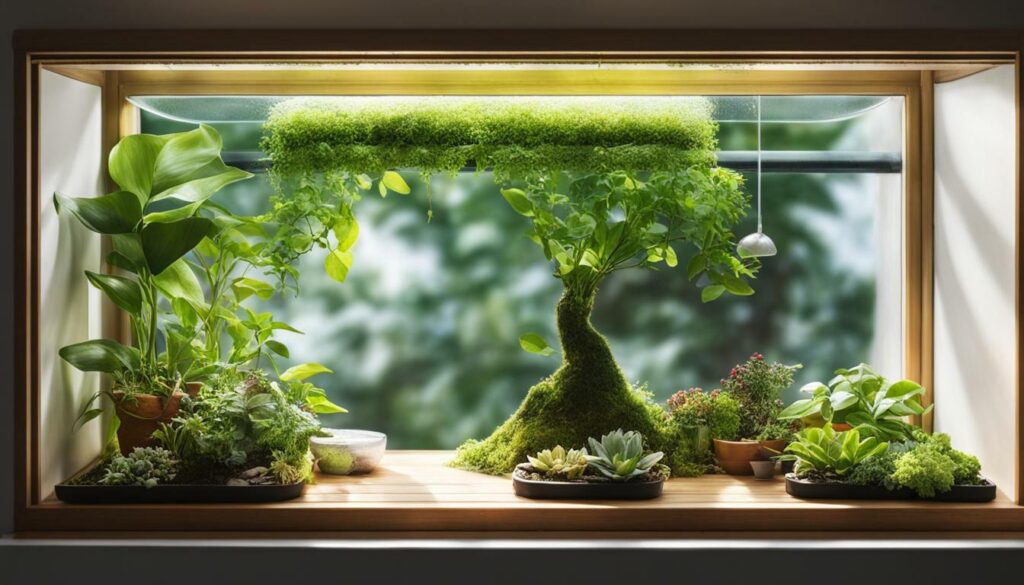
Regular pruning and maintenance are key to keeping your terrarium thriving in every season. By following proper care practices, you can ensure the longevity and health of your little green oasis.
When it comes to pruning, it’s important to trim back any plants that come into contact with the sides of the terrarium. This helps prevent overcrowding and allows for proper airflow. In addition, removing any moldy leaves or stems will help maintain a clean and healthy environment for your plants.
As for maintenance, there are a few tasks you should regularly undertake. Cleaning the terrarium is essential to remove any dust or debris that may accumulate over time. This can be done using a soft cloth or brush. If you notice any dead or unhealthy plants, be sure to replace them promptly to prevent the spread of disease.
It’s also important to monitor the moisture levels in your terrarium. Depending on the season, you may need to adjust your watering routine. During hotter months, you may need to water more frequently to compensate for increased evaporation. Conversely, in cooler months, you may need to reduce the frequency of watering as the terrarium’s moisture levels will take longer to deplete.
| Maintenance Tasks | Seasonal Adjustments |
|---|---|
| Pruning | Trim back plants touching the sides of the terrarium |
| Pruning | Remove moldy leaves or stems |
| Maintenance | Clean terrarium to remove dust and debris |
| Maintenance | Replace dead or unhealthy plants |
| Maintenance | Adjust watering frequency based on season |
“Regular pruning and maintenance are key to keeping your terrarium thriving in every season.”
Pruning Tips
When pruning your terrarium, it’s important to use clean and sharp tools to prevent the spread of disease. Sterilize your tools with rubbing alcohol or a diluted bleach solution before and after each use.
- Trim back plants that touch the sides of the terrarium to prevent overcrowding and promote airflow.
- Remove any moldy leaves or stems as soon as you notice them to prevent the spread of disease.
- Prune plants to maintain their desired shape and size, ensuring they don’t outgrow the terrarium.
Remember, regular pruning and maintenance are essential to keep your terrarium looking beautiful and healthy all year round.
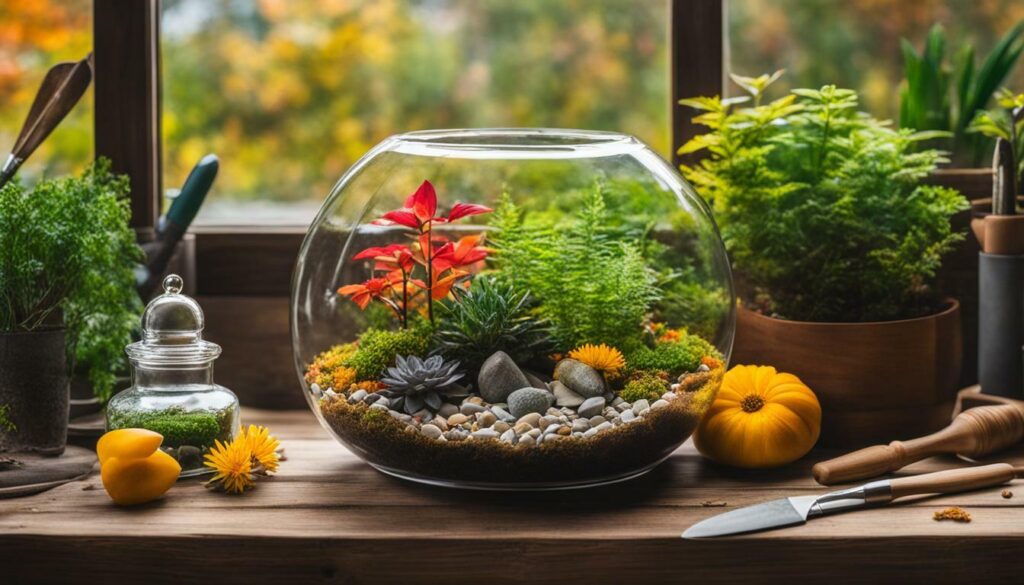
Learn how to adapt your terrarium care to address seasonal issues and keep your plants healthy.
Seasonal changes can bring about various issues in terrariums, but with the right adjustments, you can ensure the well-being of your plants throughout the year. Here are some common seasonal issues and how to troubleshoot them:
1. Overwatering in the Winter
During the winter season, terrariums tend to require less frequent watering due to lower evaporation rates. Overwatering can lead to root rot and other moisture-related problems. To avoid this issue, adjust your watering schedule accordingly. Only water your terrarium when the soil feels dry about an inch below the surface. It’s better to underwater than overwater during the winter months.
2. Lack of Humidity in the Summer
In the hot summer months, terrariums may experience lower humidity levels. This can cause plants to wilt or dry out. To address this issue, you can mist the terrarium with water daily to increase humidity levels. Additionally, you can place a shallow tray with water next to the terrarium to provide a localized source of moisture.
3. Pests and Diseases
Seasonal changes can also bring an increase in pests and diseases. In the warmer months, watch out for common terrarium pests like aphids and spider mites. To prevent infestations, regularly inspect your plants for any signs of pests or diseases. If detected, isolate the affected plants and treat them with appropriate organic pest control methods or consult a professional.
4. Sunburn in the Spring
As the intensity of sunlight increases in the spring, terrariums placed in direct sunlight may experience sunburn. Sunburned foliage appears brown or yellow and can become crispy. To prevent sunburn, adjust the placement of your terrarium to a spot with indirect sunlight or shade. You can also use sheer curtains or blinds to filter the sunlight if necessary.
By troubleshooting these seasonal issues and making the necessary adjustments, you can ensure the health and longevity of your terrarium plants. Keep in mind that each terrarium is unique, and it’s important to observe your plants closely to address any specific issues that may arise.
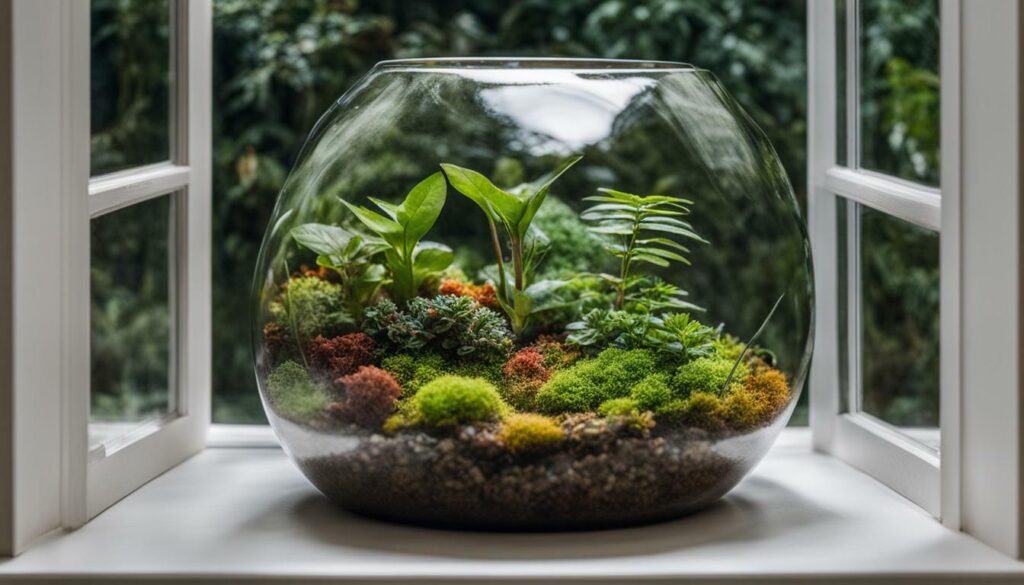
Give your terrarium the best start by following these essential tips during the settling-in period. It is crucial to provide the right conditions and care to ensure the long-term health and success of your terrarium.
First and foremost, pay close attention to the lighting and temperature of your terrarium. Place it in an area where it can receive indirect sunlight or bright, filtered light. Avoid exposing your terrarium to direct sunlight, as it can lead to overheating and damage to the delicate ecosystem within.
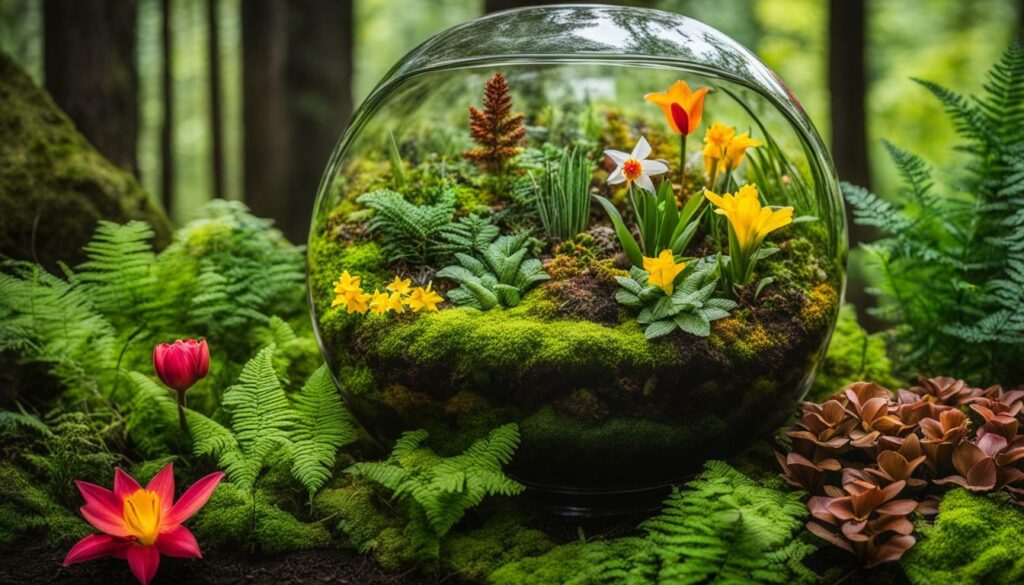
Next, be mindful of the watering needs of your terrarium. During the settling-in period, it is important to strike a balance between providing enough moisture for the plants and preventing waterlogging. Overwatering can lead to root rot and other issues. Keep the soil lightly moist, but not saturated, and monitor the moisture levels regularly.
In addition to proper lighting and watering, regular maintenance is essential for the health of your terrarium. This includes removing any dead leaves or plants, as well as any debris or buildup that may accumulate. Cleaning the glass walls of the terrarium helps maintain clarity and allows for optimal viewing of your mini ecosystem.
Expert Tip:
Remember to avoid overcrowding your terrarium with too many plants. Give them space to grow and breathe. A well-planned and well-maintained terrarium will thrive throughout the year.
During the settling-in period, observe your terrarium closely and make any necessary adjustments. This is the time to assess the placement, lighting, and watering needs based on the specific requirements of the plants you have chosen. It may take some trial and error to find the perfect balance, but with time and attention, your terrarium will flourish.
| Terrarium Care Tips during the Settling-In Period: |
|---|
| 1. Place your terrarium in an area with indirect or filtered light. |
| 2. Monitor the moisture levels and avoid overwatering. |
| 3. Regularly remove dead leaves, plants, and debris. |
| 4. Clean the glass walls of the terrarium for optimal viewing and clarity. |
| 5. Avoid overcrowding the terrarium with too many plants. |
By following these essential tips during the settling-in period, you are setting a solid foundation for the long-term success of your terrarium. Remember to adapt your care routine as the seasons change, ensuring that your terrarium thrives throughout the year.
Choosing Suitable Plants and Containers for Terrariums
Choose the right plants and containers to ensure the success of your terrarium care throughout the seasons. When selecting plants, it is important to consider their suitability for the terrarium environment. Opt for plants that thrive in high humidity and low light conditions, such as ferns, mosses, and foliage plants. These plants are better equipped to adapt to the changing seasons and will require less maintenance.
Additionally, choose plants that have similar care requirements and growth rates to create a harmonious ecosystem within the terrarium. This will ensure that all the plants can coexist and thrive together, making your terrarium a beautiful and sustainable mini-landscape.
When it comes to containers, there are a variety of options that can suit different terrarium setups. Glass containers provide excellent visibility and allow you to showcase the plants and hardscape elements. Choose containers with wide openings to make planting and maintenance easier. Additionally, containers with removable lids or openings can be ideal for closed terrariums, as they allow for better control of humidity levels.
Table: Examples of Suitable Terrarium Plants
| Plant | Care Requirements |
|---|---|
| Ferns (e.g., Boston Fern, Maidenhair Fern) | Low light, high humidity, moist soil |
| Mosses (e.g., Sheet Moss, Cushion Moss) | Low to medium light, high humidity, moist soil |
| Foliage Plants (e.g., Fittonia, Peperomia) | Medium light, high humidity, well-draining soil |
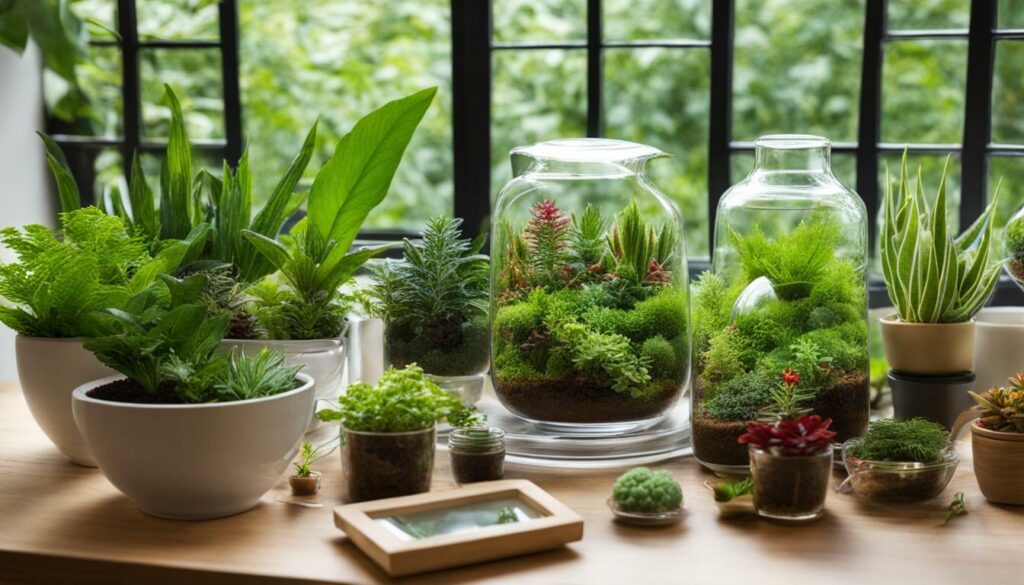 Enhancing your terrarium with hardscape elements can add a touch of visual interest and create a more natural environment. Rocks, driftwood, and small figurines can be carefully placed within the terrarium to create decorative focal points and provide additional support for the plants.
Enhancing your terrarium with hardscape elements can add a touch of visual interest and create a more natural environment. Rocks, driftwood, and small figurines can be carefully placed within the terrarium to create decorative focal points and provide additional support for the plants.
By carefully selecting suitable plants and containers, you can create a thriving terrarium that will flourish throughout the changing seasons. Remember to consider the care requirements of the plants and choose containers that offer the necessary conditions for their growth. With the right combination, your terrarium will become a beautiful and self-sustaining mini-ecosystem that brings life and greenery into your home.
Layers and Basic Care for Successful Terrariums
Master the fundamental aspects of terrarium care by understanding the layers and implementing basic care practices. Terrariums are self-contained ecosystems that require specific layers to support plant growth and create a thriving environment. These layers include drainage, soil, hardscape, plants, and finishing touches.
When setting up a terrarium, start with a layer of drainage material at the bottom. This can be small pebbles or activated charcoal, which helps prevent water from pooling and causing root rot. On top of the drainage layer, add a suitable soil mix that provides proper drainage and nutrients for the plants.
Once the layers are in place, it’s time to arrange the plants and hardscape elements. Start with the tallest or largest plants and position them towards the back or center of the terrarium. Then, add smaller plants towards the front or edges. Hardscape elements, such as rocks or driftwood, can be placed strategically to enhance the visual appeal of the terrarium.
Finally, add the finishing touches to complete the terrarium. This can include moss, which adds a lush and natural look. Moss also helps retain moisture and creates a more humid environment within the terrarium. Place the finishing touches strategically to create a visually appealing composition.
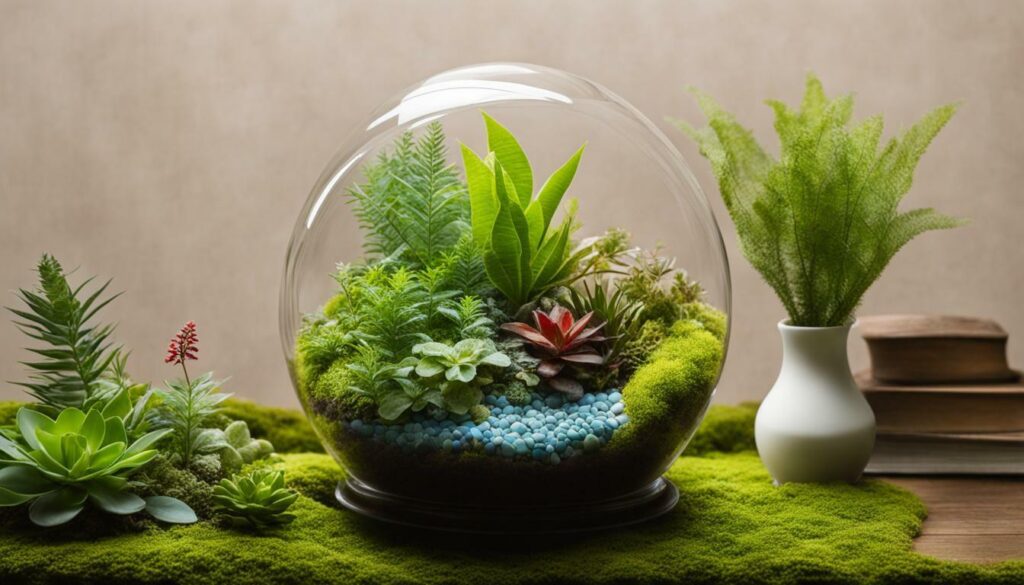
| Aspect | Best Practices |
|---|---|
| Lighting | Consider the light requirements of the plants and position the terrarium accordingly. Closed terrariums should be placed away from windows to avoid excessive light or heat, while open terrariums can be placed on a windowsill or table with full or partial sun. |
| Watering | Open terrariums should be watered weekly from March to October, while closed terrariums require less frequent watering. Monitor the moisture levels and adjust watering according to the specific needs of the plants. |
| Pruning | Regularly trim back any plants that touch the sides of the terrarium to prevent them from suffocating. Remove any moldy leaves or stems to maintain the overall health of the terrarium. |
| Maintenance | Clean the terrarium regularly and replace any dead plants. Check for signs of pests or diseases and take appropriate action. Regular maintenance ensures the longevity and health of the terrarium. |
Summary
By understanding the layers and implementing basic care practices, you can create and maintain a successful terrarium throughout the year. Pay attention to lighting, watering, pruning, and regular maintenance to ensure the well-being of the plants and the overall ecosystem of the terrarium.
Enhancing Your Terrarium with Hardscape Elements and Finishing Touches
Elevate the aesthetic appeal of your terrarium by incorporating hardscape elements and adding those perfect finishing touches. Hardscape elements, such as rocks, driftwood, or decorative figurines, can add visual interest and create a more naturalistic environment within your terrarium. These elements not only enhance the overall design but also provide hiding spots and climbing surfaces for your terrarium plants.
When choosing hardscape elements, consider the size and scale of your terrarium. Larger terrariums can accommodate bigger rocks or pieces of driftwood, while smaller terrariums may require more delicate and intricate pieces. Aim for a balanced composition, ensuring that the hardscape elements do not overwhelm or overcrowd the plants.
Adding finishing touches to your terrarium can further enhance its appeal. Consider incorporating decorative moss, colored stones, or miniature garden accessories to create a personalized and unique display. These small details can make a big difference in the overall appearance of your terrarium.
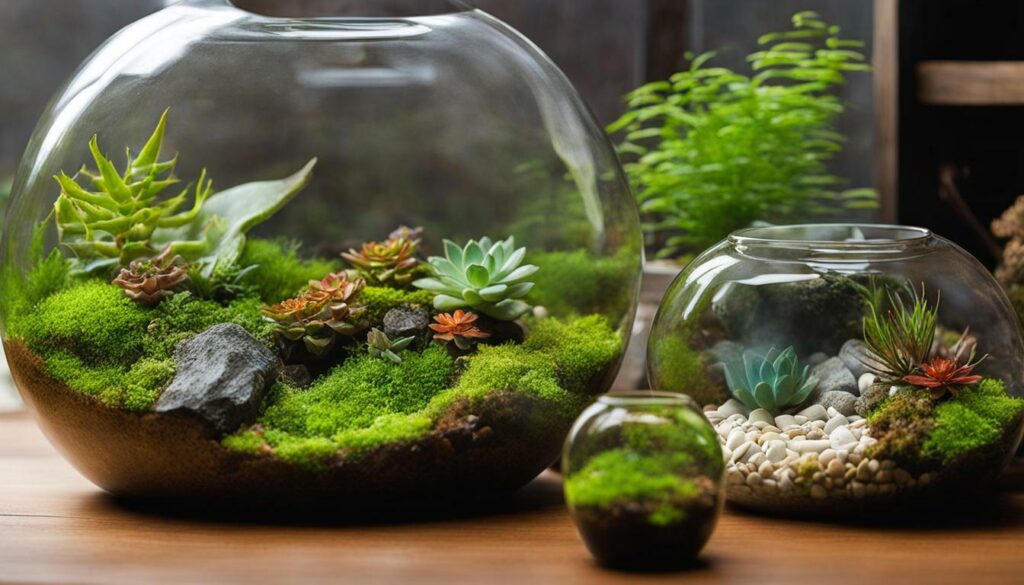
| Best Hardscape Elements for Terrariums | Finishing Touches Ideas |
|---|---|
|
|
Remember to consider the needs of your terrarium plants when selecting hardscape elements. Avoid using materials that may leach harmful substances or create an unsuitable environment for the plants.
Creating a Naturalistic Environment
To create a naturalistic environment, start by placing the hardscape elements strategically. Rocks and driftwood can be used to mimic natural landscapes or create interesting focal points. You can position them to create different levels and layers within the terrarium, adding depth and visual interest.
Next, add the finishing touches to infuse your own personal style into the terrarium. Decorative moss can be used to create lush green patches, while colored stones can add pops of vibrant color. Miniature garden accessories, such as tiny benches or animal figurines, can bring a whimsical touch to the terrarium.
By carefully selecting and arranging the hardscape elements and finishing touches, you can transform your terrarium into a miniature world of beauty and creativity.
Why is it Important to Adjust Terrarium Care for Different Seasons?
It is crucial to make seasonal terrarium care adjustments to ensure the health and vitality of the plants inside. Changes in temperature, humidity, and sunlight levels can all affect the needs of the plants, so adapting care routines accordingly is essential for their well-being.
Conclusion
By adjusting your terrarium care based on the changing seasons, you can ensure the long-term health and beauty of your mini ecosystem. Terrariums are a wonderful way to bring nature indoors, and with proper seasonal care adjustments, you can create a thriving and vibrant habitat for your plants.
When it comes to positioning your terrarium, consider the light requirements of the plants. Closed terrariums should be placed away from windows to avoid excessive light and heat, while open terrariums can be positioned on a windowsill or table with full or partial sun.
Watering your terrarium also varies depending on whether it is open or closed. Open terrariums should be watered weekly from March to October, while closed terrariums require less frequent watering. Remember to prune your terrarium plants as needed, removing any plants that touch the sides of the terrarium and getting rid of any moldy leaves or stems.
If you notice any issues with your terrarium, such as plants looking sick or moss appearing faded, take immediate action. This may involve removing excess water, trimming dead leaves or stems, or relocating the terrarium to a shadier spot. Mold should be removed promptly, and airflow should be increased if necessary.
Proper care and attention during the settling-in period is crucial for the long-term success of your terrarium. Consider lighting and temperature, and choose suitable plants and containers. The layering process, including drainage, soil, hardscape, plants, and finishing touches, should not be overlooked. Regular maintenance, such as cleaning, replacing dead plants, and keeping the terrarium tidy, is also important.
Choosing the right plants and containers for your terrarium is essential. Opt for foliage, ferns, vines, and moss that thrive in enclosed environments. Wider openings in the containers make planting easier, and a drainage layer helps prevent root rot. Ensure the soil mix provides adequate drainage and nutrients.
Enhance your terrarium with hardscape elements like rocks or driftwood. When planting, start with the tallest or largest plants and work your way down to the smallest. Adding moss as the finishing touch will give your terrarium a beautiful and natural look.
Overall, by following these care adjustments throughout the seasons, you can master terrarium care and enjoy the beauty of your mini ecosystem for years to come. So, get started on creating your own stunning terrarium and bring a touch of nature into your home.
FAQ
What should I consider when positioning a terrarium?
It is important to consider the light requirements of the plants. Closed terrariums should be placed away from windows to avoid too much light or heat, while open terrariums can be placed on a windowsill or table with full or partial sun.
How often should I water my terrarium?
Open terrariums should be watered weekly from March to October, while closed terrariums require less frequent watering.
How do I prune my terrarium plants?
Trim back any plants that touch the sides of the terrarium and remove any moldy leaves or stems.
What should I do if my terrarium is sick?
If your terrarium is sick, it may be getting too much light. Remove excess water, trim off dead leaves or stems, and move the terrarium to a shadier spot.
How can I revive faded moss in my terrarium?
Adding a spoonful of water can revive faded moss in your terrarium.
How do I care for my terrarium during the settling-in period?
During the settling-in period, pay attention to lighting and temperature, clean the terrarium, replace dead plants, and ensure proper maintenance.
What types of plants are suitable for terrariums?
Suitable plants for terrariums include foliage, ferns, vines, and moss.
What kind of containers should I choose for my terrarium?
Choose containers with wider openings to make planting easier.
What are the essential layers in a terrarium?
The essential layers in a terrarium include drainage, soil, hardscape, plants, and finishing touches.
How can I enhance my terrarium with hardscape elements?
Hardscape elements like rocks or driftwood can enhance the overall look of your terrarium.

